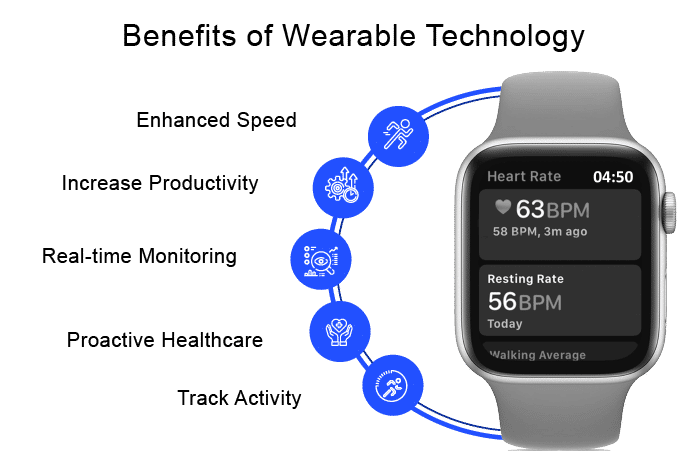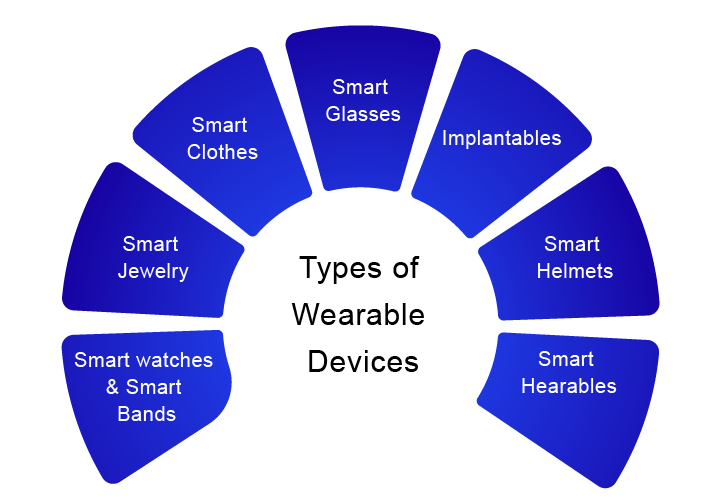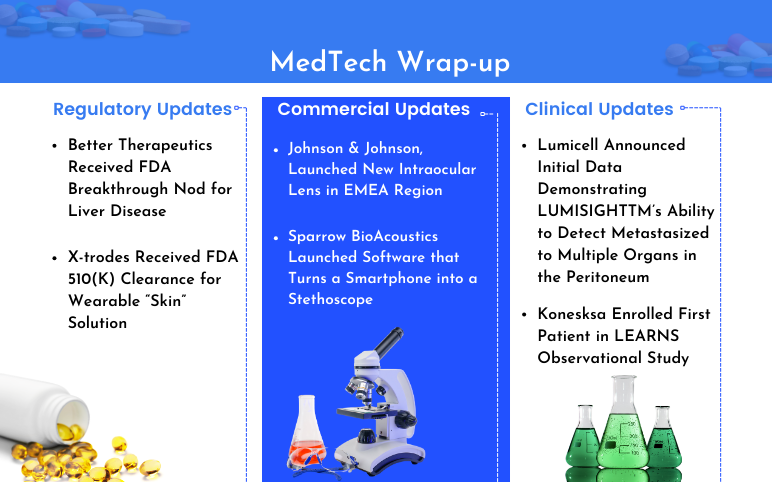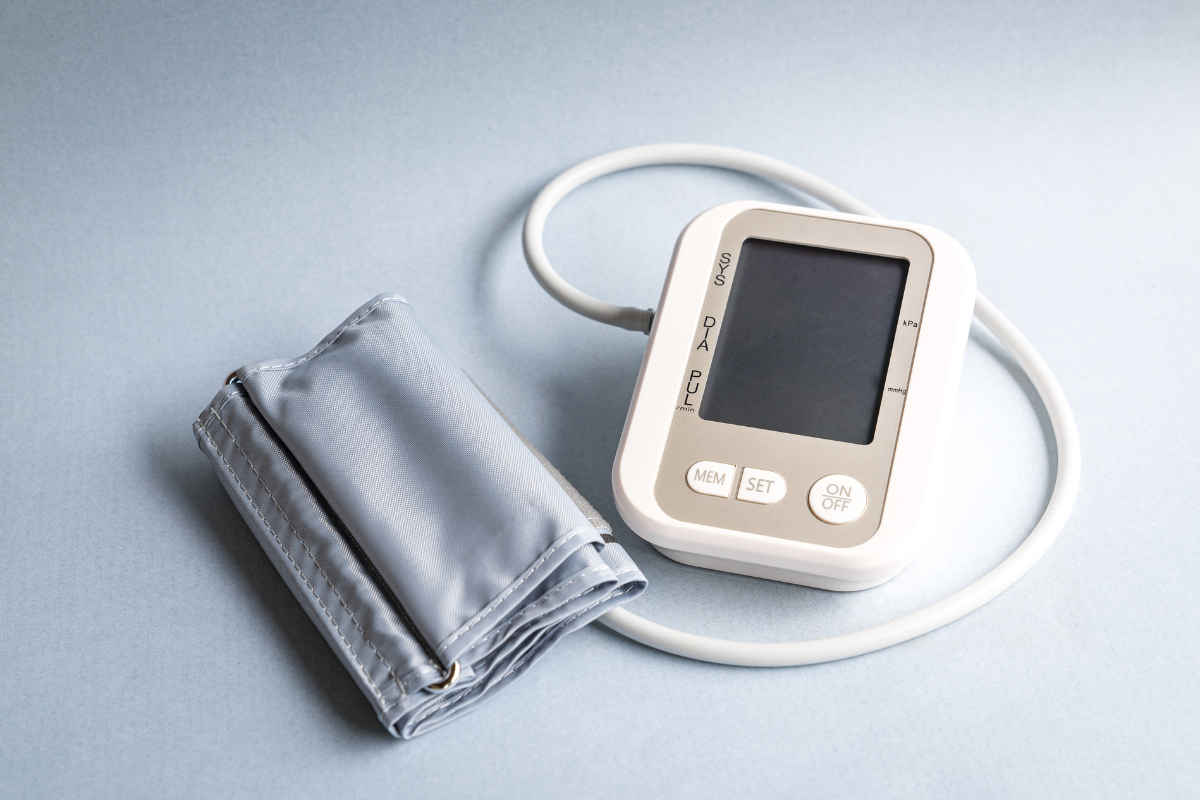Table of Contents
Many tech companies, especially wearable technology companies, have spent the last two years focusing on using their skills to address issues created by the worldwide pandemic. Simultaneously, many healthcare firms that would not have been called tech companies in the past have shifted their focus to technology and its potential to revolutionize how their products and services are delivered. It’s apparent that the pandemic has hastened the healthcare industry’s digitalization. Because of technological advancements in wearable technology in healthcare, we can now track useful information more quickly, making our lives more fluid and simple.
Wearable devices available on the market analyze a wide range of physiological data over time, including heart and respiration rates, blood pressure, temperature, and sleep activities. The information gathered can assist healthcare practitioners in disease diagnosis and therapy.
Similarly, individuals suffering from chronic diseases such as diabetes and high blood pressure can rely on these wearable devices to improve the management and monitoring of their cardiovascular function. Wearable health technology is becoming more popular as it is simple to use and convenient. People have started to purchase these wearable devices. Now the question is, what is wearable technology?
What is Wearable Technology?
Wearable technology or wearables are the electronic devices that are worn on a person’s body (typically close to the skin) to send vital medical, biochemical correctly, and exercise data to a database. The Apple Watch and Fitbit are iconic examples of wearable technology, but they’re not the only ones being produced today. Smartwatches, VR and AR technologies, smart coats, and a plethora of other wearable devices, in addition to smartwatches, are guiding us toward a more connected existence.
The primary function of each device is to capture millions of data points ranging from counting the steps to monitoring heart rate. Wearing mini wearable devices can improve the user’s working capacity and modify the way they function in this fast-paced environment.

But wearable health technology has some challenges too. Many wearable devices have short lifespans due to low customer engagement. Some of the functional reasons that turn users off the device are poor quality, difficulty syncing with smartphones, poor battery life, uncomfortable and awful design, and UX issues. Now the question is, does this wearable technology is useful?
Benefits of Wearable Technology
Wearable health technology, such as fitness trackers, smartwatches, and smart clothes, has seen a boom in popularity over the last decade. Consumers and businesses are beginning to employ diverse wearable devices for several purposes. With no signs of slowing down and a rising influence on society, let us analyze the benefits of wearable technology.

Track Activity and Increase Productivity
Nowadays, tracking is an essential part of our routine since it helps us to organize our lives and duties better. Wearable devices, such as smartwatches and bands, are examples of wearable devices that can track users’ activity and health status. Furthermore, wearable technologies are beneficial in large supply chains where workers must constantly monitor and evaluate the product stream since these gadgets are persuasive for increasing efficiency.
Enhanced Speed
In an era where every second counts, no one can’t afford to waste time retrieving items from bulky gadgets. But how can one manage its time and speed up the work? There is a solution to this problem, and it is called wearable technology. Smart clothing, 5G-enabled gadgets, smartwatches, AR & VR wearables, and other wearable technologies are designed to improve speed.
Improve Patient Care
Wearable technology in healthcare provides important information to surgeons and physicians to enhance decision-making while boosting possibilities for patient interaction. Smart glasses, for example, can be used to display patient vitals and pertinent information during surgical procedures without moving one’s gaze away from the patient.
Benefits Healthcare Providers
Wearable technology in healthcare has the potential to drastically improve the lives of healthcare workers. Medical providers can better understand the difficulties impacting their patients by employing wearable devices to monitor patient data over time. They can then utilize the data to make a more accurate diagnosis than they could before using the gadget.
Encourages Proactive Healthcare
Wearable technology in healthcare has the potential to provide a more proactive approach to healthcare. This is because wearable technology in healthcare can be used to intervene early in the course of a health problem rather than reacting to it after it has begun to cause problems. In persons who are predisposed to health issues, abnormalities can be recognized before they cause difficulties.
Discover more about Wearable Technology in the Healthcare Industry
Now that we’ve seen some of wearable technology’s most well-known benefits, it’s time to look at the wearable technology trend 2022.
Top Wearable Technology Trends for 2022
What are the major wearable technology trends and debuts in 2022? We’re eagerly anticipating what promises to be another fascinating year in the wearables industry. Who or what will get us talking and break new ground for the electronics we wear on our wrists, ears, and other parts of our bodies? Let’s take a look at some of the most important wearable technology trends to keep an eye on in 2022.

Smart watches and Bands
Smart watches and bands are most likely the most well-known and widely used fitness trackers in the workplace today. When a smart watch is linked to a mobile device, the wearer can read and send new messages directly from their watch, eliminating the need to hold and view one’s phone. The smart watches and smart bands track vital health metrics such as step count, heart rate, calories burned, fall detection, sleep tracking, blood pressure, blood oxygen monitoring, emergency SOS, and many more. Designers of smartwatches and bands are constantly looking for new ways to innovate.
There are a plethora of smart watches and smart bands available in the market. Furthermore, leading tech companies such as Apple, Samsung, Oppo, Sony Corporation, Fitbit, Huawei Technologies Co., Fossil, Garmin, and many others are developing more smart watches and smart bands with more advancements. In addition, Meta/Facebook is also looking to compete with these companies by launching its smart watch in the market, possibly in 2022.
Smart Clothing
Smart clothes are high-tech garments that include built-in technology that extends their functionality beyond their usual application. These smart wearable clothing can communicate with phones and computers via particular apps, allowing users to keep track of their active metrics and crucial biometrics. These smart wearable clothing also enable the user to monitor their health and performance, which is critical for staying healthy.
There are various types of wearables that come under smart wearable clothing, such as Smart shoes, Smart work clothes, Smart sleepwear, Smart activewear, Smart casual wear, Smart socks, and many more. Currently, many smart wearable clothing is available in the market, including Siren Socks (smart socks that detect growing foot ulcers), Nadi X smart trousers from Wearable X (yoga pants that vibrate to enhance form during yoga activities), Naviano smart swimwear, and others.
Furthermore, Samsung undertakes substantial research in this field and has filed a number of interesting patents; if these patents are commercialized, Samsung may soon deliver smart shirts capable of diagnosing respiratory problems and smart shoes that monitor running form.
In addition, many companies such as AiQ Smart Clothing, Sensoria Inc., Athos, Vulpes Electronics, Cityzen Sciences, Tommy Hilfiger, OmSignal, BioMan, Ralph Lauren, Under Armour, Levi’s, are also experimenting with their smart wearable clothing and will soon launch new products in the market.
Smart Helmets
Most individuals are bored and sometimes fed up with wearing normal helmets. But now there are smart helmets with built-in speakers and GPS. These helmets employ capacitive coupling, which transforms sound into vibration and allows users to listen to music while riding.
Aside from that, these helmets enable users to make calls measure the rhythm, calorie burn, route, pace, stamina, and many other things. The market for smart helmets is promising as many individuals are turning to smart helmets to have fun while staying safe. We can witness many novel products in the smart helmets category in the near future.
Smart Glasses
Smart glasses, also known as wearable computer glasses, are among the most interesting wearable technology trends in 2022; they’re an exciting experiment that will improve productivity and working capacities. AR (augmented reality), VR (virtual reality), a camera, Bluetooth, built-in headphones, noise cancellation, facial recognition, health sensing, audio recording, and other functions are included in these smart glasses.
These spectacles make the user feel as if they are carrying a mobile phone in their eyes since they can do practically all of the functions of a phone. The available smart glasses in the market include Google’s Glass, Microsoft’s Hololens, Snap’s Spectacles, and Facebook’s Ray-Ban Stories glasses.
Furthermore, Apple is also looking beyond phones and will soon launch its smart glasses in the market. In addition, Huawei is planning to spread its HarmonyOS operating system through smart glasses in 2022.
Explore our latest blog to find out Which other trend drives the healthcare industry in 2022
Smart Rings
The idea of embedding technology in the finger appears implausible, but it is not. Wearing smart rings on the finger allows users to monitor their health, swipe up for payments, and receive important notifications. These smart rings are becoming popular among people who spend a lot of time in meetings and want to receive notifications without looking at their phones.
People can also use these mini wearable devices to unlock their cars and control some of their household devices. These smart rings are available in various colors and styles, giving a large selection to choose from. Currently, Oura is dominating the smart ring market, but it appears that it will face competition in 2022, with the release of the Movano Ring in the second half of the year.
Smart Hearables
Smart hearables are in-ear devices that are technologically advanced and designed for wireless transmission, medical monitoring, and fitness tracking. These devices are among the best wearable technology trends in 2022 because they allow people to listen to music while also monitoring their health. As technology advances, what was once merely a science-fiction possibility may soon become a reality. Hearables can already track health data like blood pressure, and they’re starting to track our biological signals and stress levels.
Hearables same as smart watches and smart bracelets, use embedded microchips and smart sensors to monitor personal user data. To enhance the user experience, these hearable gadgets can link to smartphones or other electronics via Bluetooth, Wi-Fi, or a cellular network.
Smart Implantables
Implantables contact the user’s body from within rather than from the outside. For example, the now-bankrupt company Proteus produced sensor-containing pills that could monitor blood pressure and other health metrics; after swallowing the pills, the patient could wear an external device to monitor the data generated from within the body easily. Smart tattoos may become available in the near future for patients who want an easy way to remember to bring their monitoring devices with them.
What Lies Ahead?
Wearable technology in healthcare is becoming increasingly popular as people prioritize their health and fitness. Because of advances in technology, wearable technology in 2022 is far superior to that of the previous five years. Those, as mentioned earlier, are some of the best wearable technology trends for 2022, which will improve the working capacity and make it easier for the user to check their health status while having fun with these devices.

There are numerous wearable technology trends for 2022, ranging from smart wearable clothing to smart helmets, smart glasses to smart rings, smartwatches to smart implantables, that can purchase to make the routine more seamless. Furthermore, improvements in microprocessors, operating systems (OS), and user interfaces (UI), as well as the introduction of artificial intelligence (AI), the Internet of Things (IoT), and big data, will help to provide faster solutions, driving demand for wearable devices even further.
FAQs
Wearable technology or wearables are the electronic devices that are worn on a person’s body (typically close to the skin) to send vital medical, biochemical correctly, and exercise data to a database.
Wearable technology allows users to track their fitness levels, track their whereabouts via GPS, and see text messages more rapidly. Best of all, most of the technologies that enable us to do so are hands-free and portable, removing the need for us to take our smartphones out of our pockets.
There are various types of wearables devices available in the market including smartwatches, smart bands, smart clothing, smart jewelry, smart helmets, implantables, smart glasses, and many more.
Leading tech companies such as Apple, Samsung, Oppo, Sony Corporation, Fitbit, Huawei Technologies Co., Fossil, Garmin, and many others are currently working and developing more smartwatches and smart bands with more advancements.









-Agonist.png)


